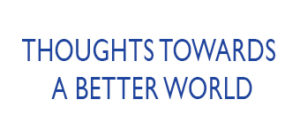#91 – Dick Bernard: Photo-shoppe
Years ago, in some unremembered periodical, I recall seeing two seemingly identical black and white photos. Both were of some stern looking Communists during Stalin’s time: all men wearing suits. The casual observer would have seen no difference in the photos. But the caption pointed the reader to a particular place in the photo. In the first photo, a man occupied the space; in the second, that man had been disappeared.
Somebody with the Stalinist Russia version of Xacto knife had modified an official photo, simply removing some errant comrade who had been purged, possibly liquidated for unremembered sins against the Party. It was cheaper and more efficient to simply modify the photo, than to regather the group and take a new one.
It was my introduction to a primitive Photoshop.
I can remember many subsequent examples of the same tactic:
In the mid 90s, one of my colleagues at work retired, and there was the usual fete. His work colleague, a guy a bit more technologically savvy and interested than the rest of us, had purchased a home version of Photoshop or equivalent, and had placed Roger’s head atop a photo of a magnificent slam-dunking Michael Jordan’s body. Roger was a fit guy, but no Michael Jordan. The hatchet job was done pretty well, and the projected work of art got a lot of good laughs. Welcome to the world of manipulating images.
The most dramatic example of the art of manipulating information through photos came, for me, during the early Iraq War in 2003. It is the famous film footage of the statue of Saddam being toppled by supposed hordes of grateful Iraqis, happy that the dictators term had come to an end. Most of us can remember this iconic piece of film footage: the supposed triumph of freedom over tyranny. It was really nothing more than a military psychological operations tactic to manipulate both the Iraqis and ordinary Americans.
Fewer of us remember, because it takes some work and interest to find this out, that the particular piece of news film did not portray reality at all. In a pretty obvious piece of collusion between media and government, the film shown on television focused tightly on the statue falling, and it was only later that it was found that there were only a handful of Iraqis actually at the site to watch Saddam take his fall from prominence.
Democracy had triumphed over evil.
But had it? What difference was there between the excised communist in Stalin’s Russia; and a dishonest piece of photography in 2003 United States of America?
No difference, I would submit.
When it comes to technology, 2003 is long ago and far away, as we all know. But many of us come from the old Kodak-moment days when you were stuck with what you got on that photo you took in Grandma’s back yard. Most of us have gone digital now, but we are not familiar with the many and sundry ways that perfect lies can be concocted simply by manipulating images.
Most recently, the obvious lie of the photo of millions of people at the 9-12 event, was quickly replaced by less obvious lies which can be fashioned through not only the way pictures are taken these days, but which of these photos are used, and how the photographs are manipulated through means such as the ever more sophisticated photo-editing devices. A skillful practitioner can make a crowd of hundreds look like tens of thousands…. CNN carried an interesting after-the-fact commentary on the manipulation of the event by Fox News #mce_temp_url# .
In the past, a photographer was limited by how many photos he or she could take with the old Nikon; today’s digital technology potentially gives the “news” photographer tens of thousands of images to pick from, so today’s American version of commissars need to be well-trained in attempting to avoid embarrassment from not only unpleasant edits of their image, but covert and malicious photography as well.
We can’t go back to the past, but the prudent consumer is skeptical.
Caveat emptor.
